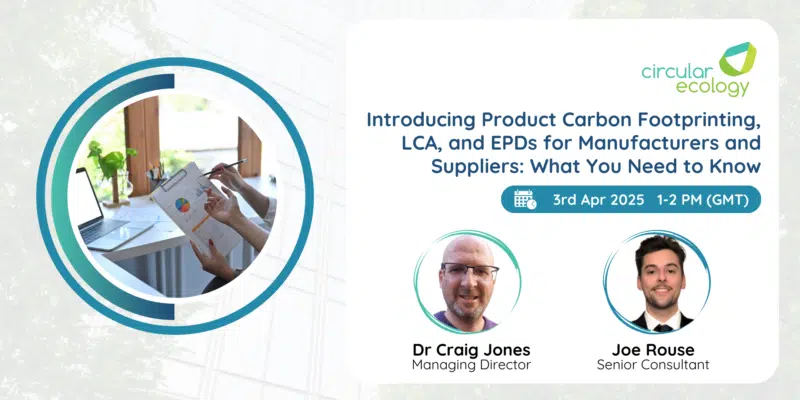Embodied Carbon - The ICE Database
Embodied carbon comes from the consumption of embodied energy consumed to extract, refine, process, transport and fabricate a material or product (including buildings). It is often measured from cradle to (factory) gate, cradle to site (of use), or cradle to grave (end of life). The embodied carbon footprint is therefore the amount of carbon (CO2 or CO2e emission) to produce a material.
It is a topic of rising importance. In fact, it is normally possible to reduce the embodied energy and carbon of a building or construction project by 10-20% without adding to the build cost. What’s more, embodied carbon is often 20-50%, or so, of the whole life energy and carbon of a building, i.e. when operational carbon emissions are considered.
The embodied carbon life cycle of a building can be expressed on a single diagram, as below.

So if you’re not looking at the embodied carbon of your project, then you are missing out on a valuable opportunity. This is where the Inventory of Carbon & Energy database can help. The ICE database is a useful source of embodied carbon data and is available for free from this page (fill in the form below).
Download your free embodied carbon database - over 50,000 users
The ICE Database can be downloaded for free by submitting the form below, which takes you to an ICE download button.
The ICE Database now has two versions, both remain free resources:
- ICE Database Educational: Obtained by the download form below. Free for use for any Educational purposes (i.e., learning, teaching, and academic research). It contains all the emissions factors, but the advanced version contains extra detail.
- ICE Database Advanced: Users may obtain the ICE Database Advanced version by registering as an ICE Database user. The advanced version contains a Machine-Readable format, material profiles, and a Concrete and Cement tool.
Please see our summary of the ICE Database Registration Process.
In order to help support future maintenance and development of the ICE database, we have also developed an ICE Database Supporter System.
ICE v4.0 (Dec 2024) – Out Now!
Note: If you have any issues with the below form displaying, please try from another device or internet network, otherwise please contact us.
About the ICE Database
The Inventory of Carbon and Energy (also known as the ICE Database) is an embodied carbon database for building materials, available for free on this page. Our founder, Dr Craig Jones, created the ICE Database in his former role as a researcher at the University of Bath whilst working for Professor Geoff Hammond, at the Sustainable Energy Research Team (SERT).
The ICE Database originally contained embodied energy and embodied carbon factors. However, since 2019, embodied energy factors are no longer included. The data in the wider literature, which the ICE Database relies upon, generally no longer reports the embodied energy of construction products. Instead, embodied carbon has become the main metric. Carbon emissions give a better indicator of the contribution of that energy to global warming and climate change.
In total, the ICE Database has been downloaded by over 50,000 professionals from around the world and it appears in countless reports, journals, books, lectures, embodied energy and carbon footprint calculators, and more.
It contains data for over 200 materials, broken down into over 30 main material categories, such as:
- Bricks
- Cement
- Concrete
- Glass
- Timber
- Plastics
- Metals
- Minerals and stone
- Many more…
The energy data provides the energy consumed to make a building material. This then gives rise to embodied carbon emissions, contributing to global warming and climate change.
Creating an embodied energy and carbon database
The ICE Database was created from a large review of the literature. The first version was released in 2005 and has been updated periodically. The diagram below shows how the database was created.

Registration for Non-educational Use
The ICE Database remains a free resource. However, in order to better understand where and how the data is used, users are now required to register for permission to use the data for non-educational purposes. Registration can be completed on the Register ICE page.
Please also see:
- Our Frequently Asked Questions (FAQs)
- How to Support ICE
- ICE Database Supporter System
- Our Scaling Carbon Reductions Initiative
Latest Version
The latest version of the ICE database is:
- ICE Database Educational V4.0 – Dec 2024
- ICE Database Advanced V4.0 – Dec 2024 (obtained by registering as a user)
- ICE Cement, Mortar and Concrete Model – V1.2 – Dec 2024
- ICE Database Machine Readable is now contained within the main Excel file of the Advanced version
Check back here in the future to make sure that your version is the most up-to-date.
Please connect with us through LinkedIn, Twitter, or by sharing this page.
Webinar Recap: Product Carbon Footprinting, LCA, and EPDs
On Wednesday, April 3rd, Circular Ecology delivered our fourth webinar of 2025: Product Carbon Footprinting, LCA, [...]
Apr
New ICE Database Webinar Series Announced
We are pleased to announce the ICE Database Insights 2025 webinar series, a five part [...]
Mar
Upcoming Webinar: Product Carbon Footprints, LCAs, and EPDs: What You Need to Know
Join Circular Ecology for a webinar on Product Carbon Footprints Circular Ecology invites you to [...]
Mar
ICE Database Surpasses 1,000 Registered Organisations in Just 90 Days!
The ICE Database is experiencing unprecedented adoption, with over 1,000 unique organisations registered within just [...]
Mar




